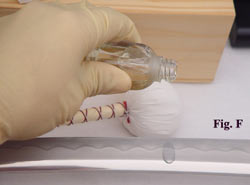Caution - the blade of your Katana is extremely sharp and may cause serious injury. Make sure that the blade edge is never in a position where it could injure yourself or others. Never clean or oil the blade with the edge towards you and avoid touching the edge at all times. Never draw or sheath the Katana with edge towards you. Never allow children to handle the Katana.
Unsheathing and sheathing the Katana
The blade fit in the scabbard (saya) is deliberately firm to avoid accidental unsheathing. Do not unsheathe the blade by simply pulling the handle and the scabbard apart, this is dangerous and will wear the scabbard throat (koiguchi). To correctly unsheathe the blade, hold the wrapped section of the scabbard with the left hand (edge side up) and the handle with the right hand. With the left thumb push away the guard (tsuba) away from the throat of the scabbard (Fig. A). When the friction resistance is broken, slide the blade gently from the scabbard, making sure the back of the blade, not the edge, contacts the scabbard during the withdrawal (Fig. B). This avoids dulling the blade and cutting the scabbard.
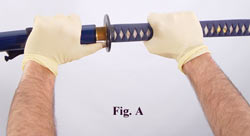
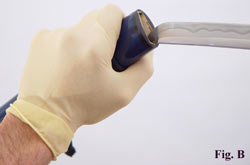
To re-sheath the blade, hold the katana handle in the right hand, edge up, and the scabbard by the wrapped section with the left hand, making sure that the scabbard is curving in the same direction as the blade. Carefully insert the tip of the blade into the throat of the scabbard and gently slide the scabbard and blade together, again making sure that the back of the blade, not the edge, is in contact with the scabbard. Resistance will be felt when the guard is within about an inch of the scabbard, and a slightly firmer push will then be needed to fully seat the blade.
Always store your Katana horizontally with the edge side up. This prevents the edge from bearing on the scabbard and preserves the condition of both. If the fit between the Katana and the scabbard becomes loose, through usage, the fit must be restored to prevent accidental unsheathing.
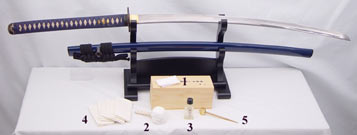
Contents of Maintenance Kit (above)
- Cotton Cloth
- Powder Ball, for applying polishing powder to blade
- Sword Oil
- Rice Paper, for cleaning oil from the blade, polishing and spreading oil on the blade
- Brass Hammer, for removing and installing bamboo pins in grip. While this tool is a traditional part of the maintenance kit, we strongly recommend against disassembly of the Katana as the bamboo pins will wear, resulting in a loose grip. Do not remove the handle without having formal training.
Maintaining your Katana
The scabbard of your Katana is finished in many coats of black lacquer. To preserve the sheen, the scabbard needs only to be wiped occasionally with a very soft cloth. Handle the scabbard only by holding the wrapped section; otherwise fine scratches caused by handling the lacquered sections will dull the finish.
Blade maintenance is very important to preserve the finish. The maintenance kit allows you to maintain your blade the same way as original pieces were (and are) maintained. Blade maintenance should be performed at least every three months and any time the blade is touched (skin oil will cause rapid corrosion of fine steels).
Blade maintenance
First, use a sheet of rice paper to remove oil from previous maintenance, holding the edge away from you and working very carefully to avoid injury. (Note: if you wish to save the rice paper, a soft cotton cloth may be substituted) (Fig. D)
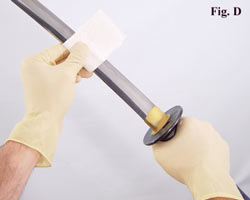
Then tap the powder ball lightly against the blade every two inches or so along its length, dusting the blade very lightly with powder. (Note: when using the ball for the first time, you may need to tap the ball against the blade a few times to “start” the powder flow through the fabric of the ball.) Then use a clean piece of rice paper or cotton cloth to carefully rub over the powder to polish the blade. Repeat until both sides of the blade have been polished and the powder is removed. (Fig. E) Do not inhale the powder.
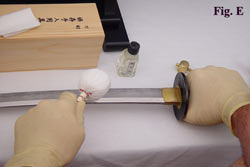
Apply a few drops of oil along the length of each side of the blade and use a piece of rice paper or cotton cloth to spread the oil evenly over the blade. Be sure not to touch the blade again before re-sheathing. (Fig. F)
